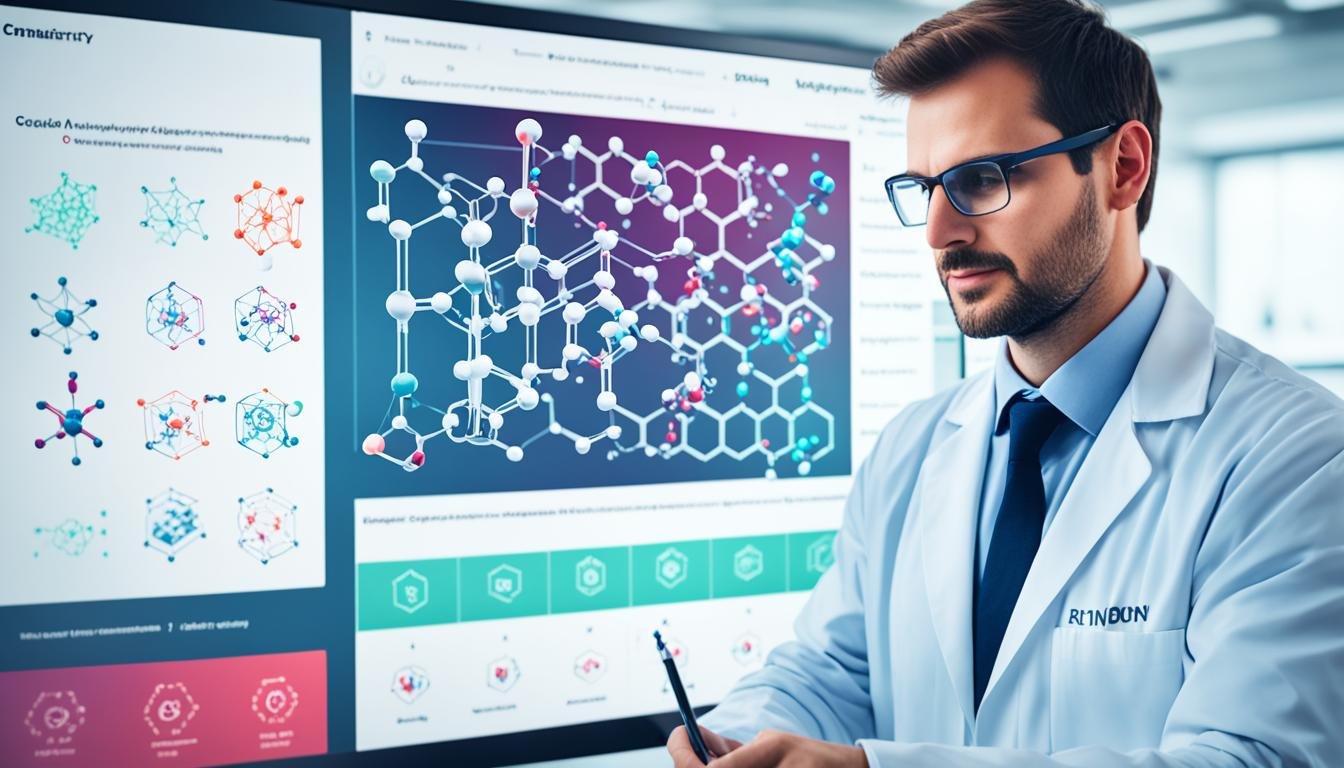Imagine a world where complex chemistry problems are solved quickly and accurately. That’s what over 15,000 students experience every day with AI-powered chemistry solvers. These tools are changing how we do chemistry, opening new doors for students, researchers, and teachers.
This article will explore how AI is changing chemistry problem-solving. We’ll look at what it can do, its benefits, and what the future holds. If you’re a student struggling with chemistry, a researcher into molecular modeling, or a teacher looking for new ways to teach, this guide is for you. It will give you the knowledge to use AI to its fullest in chemistry.
Key Takeaways
- AI is changing chemistry, offering powerful tools to solve tough problems.
- AI helps students understand and master chemistry by solving problems.
- AI changes how chemists and researchers work on tasks like molecular modeling and predicting reactions.
- The HyperWrite Chemistry Assistant is an AI tool that makes complex chemistry problems easier.
- Using AI in chemistry can lead to new discoveries in drug development and material science.
What is an AI Chemistry Problem Solver?
A new generation of AI tools is changing how we solve chemistry problems. An AI chemistry problem solver uses advanced AI and machine learning to help chemists and students. It makes solving chemistry challenges more efficient, accurate, and accessible.
Understanding the Capabilities of AI in Chemistry
AI in chemistry is amazing. It can predict molecular structures, simulate chemical reactions, and analyze data. AI helps professionals save time, get more precise results, and find new insights.
How AI is Revolutionizing the Field of Chemistry
AI is changing how we solve chemistry problems. AI chemistry problem solvers give quick solutions and step-by-step help. They help everyone from students to experts in chemistry research and development.
| Key Capabilities of AI Chemistry Problem Solvers | Benefits |
|---|---|
| Rapid problem-solving | Increased efficiency and productivity |
| Precise and reliable solutions | Improved accuracy and reliability |
| Accessibility and instant assistance | Convenience and on-demand support |
| Customized solutions for diverse users | Inclusive and tailored experiences |
| Step-by-step explanations | Enhanced understanding of chemistry concepts |
The field of ai in computational chemistry and ai molecular modeling is growing fast. Using quantum chemistry simulations and reaction prediction with ai will change how we solve complex chemistry problems. The future of AI in chemistry is very promising, promising big changes in scientific discovery.
AI Chemistry Assistant: Your Personal Tutor
Chemistry can seem tough, but an AI chemistry assistant can make it easier. These tools act like your personal tutor. They help you understand chemical principles and solve problems.
The AI Chemistry Assistant has a premium plan for $19.99/month and an ultra plan for $44.99/month. You can get a 50% discount on your first month’s subscription with the code ‘TRYHYPERWRITE.’
Advanced AI models in the Chemistry Assistant can solve many chemistry problems. It helps students, researchers, and teachers. This tool supports you at every step.
You can try the Chemistry Assistant for free before subscribing. It offers step-by-step solutions and detailed explanations. This AI assistant changes the game in chemistry homework help with ai and chemistry exam preparation with ai.
Even though the AI solutions are accurate, always check the information. If you’re unsure, talk to experts. The ai chemistry assistant can help you do your best in chemistry.
See how the Chemistry Assistant can change your chemistry learning. It makes ai-powered chemistry problem solving easier and more fun.
Solving Complex Chemistry Equations with AI
Step-by-Step Solutions for Chemistry Problems
AI is changing the way we solve chemistry problems. AI-powered chemistry problem solvers can handle complex equations and formulas. They give users step-by-step solutions that explain the concepts and principles.
These AI tools use smart algorithms to understand the problem, break it down, and guide users. They automate solving chemistry equations, saving time and effort. This helps users understand chemistry better.
At Freie Universität Berlin, a team has made a big leap in quantum chemistry. They’ve created an AI method to solve the Schrödinger equation efficiently. This method is very accurate and fast, as seen in the Nature Chemistry journal.
Old methods in quantum chemistry had trouble with the wave function. This made predictions about molecules not very good. The ‘Quantum Monte Carlo’ method from Freie Universität Berlin is much more accurate and affordable. It might even beat other methods like density functional theory.
Combining physics with AI is key for making good predictions in quantum chemistry. The team faces many challenges before their method can be used in industry. But, the promise of step-by-step chemistry solutions with AI is huge.
AI-Powered Molecular Modeling and Simulations
Computational Chemistry with AI
Computational chemistry has changed a lot with AI. Now, AI helps simulate molecules, predict their shapes, and model complex reactions fast and accurately. This is making big changes in drug discovery, materials science, and renewable energy. Scientists can now look at many solutions quickly and find the best ones easily.
AI has brought new ways to simulate things. For example, the AIQM1 method uses machine learning to make traditional quantum mechanics better. It’s as accurate as some complex methods but much faster. This means scientists can do complex tasks, like figuring out a C60 molecule’s shape, in just 14 seconds. That’s a big improvement over the 30 minutes it took before.
AI and chemistry work together well. AI models can accurately predict things like how molecules behave and their properties. This helps chemists do their work better. By picking the best compounds early, AI helps avoid wasting time and resources, speeding up research.
AI in chemistry is making a big difference. It helps researchers do more with less effort and more precision. This is opening up new possibilities in fields like drug discovery and materials science.
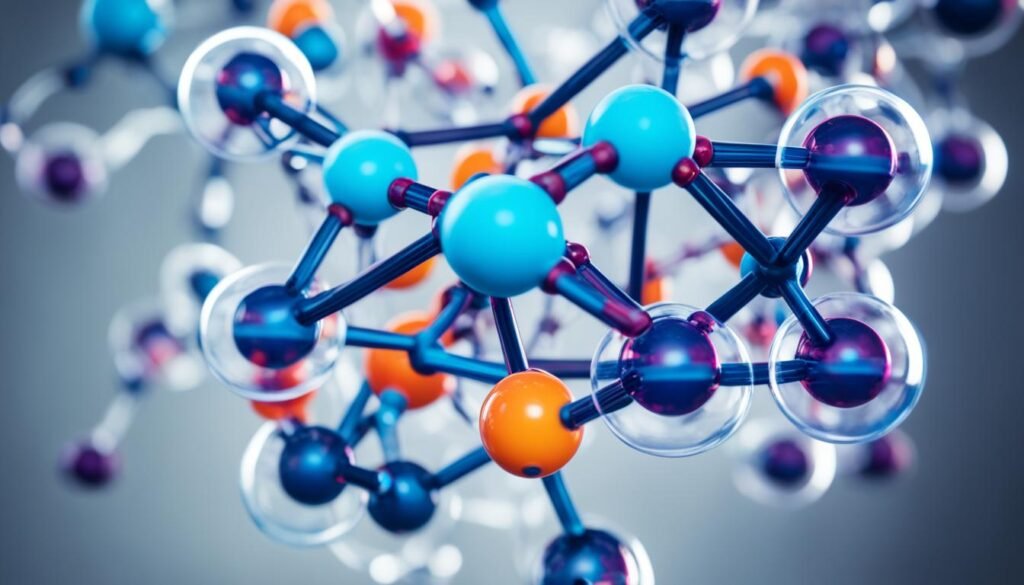
“The synergy between AI and chemistry dates back to the mid-20th century when the first computers were used for chemical computations. The development of machine learning and data-driven approaches in chemistry gained momentum in the late 20th century.”
Reaction Prediction and Synthesis Planning with AI
AI is changing how chemists work with ai reaction prediction and ai-assisted synthesis planning. It uses machine learning to look at lots of chemical reactions. This helps predict new ways to make materials and chemicals with specific properties.
GraphRXN is an AI tool that’s really good at predicting reactions. It has an R2 accuracy of 0.712 on its own data. This is thanks to its “differential reaction fingerprint” (DRFP) method, which gives it better predictions.
AI systems are also being used with robots to make chemistry faster. By using ai reaction prediction with robots, making new compounds and materials is quicker. This speeds up scientific discoveries.
Even though there are still challenges, AI is making big strides in chemistry. As AI gets better, chemists will be able to make new chemical solutions faster.
“The integration of AI systems with reaction robotics has the potential to revolutionize the way we approach chemical synthesis, accelerating the pace of scientific discovery.”
Chemical Property Prediction Using Machine Learning
The field of chemistry has seen a big change thanks to AI and ML. These new technologies are key in predicting chemical properties. They’re changing how chemists do their research. AI and machine learning models can now predict things like solubility, reactivity, and stability of molecules.
AI models learn from big datasets of experimental data. This lets them spot patterns and make good predictions about substances. This is a big deal, speeding up things like drug discovery and material design in chemical research.
AI’s Role in Predicting Chemical Properties
Machine learning for chemistry has changed the game, making complex problems easier to solve. Researchers use algorithms like linear regression and Neural Networks to predict molecular properties.
Chemical property prediction with AI is great when we don’t know the physical laws or when it’s hard to find relationships. By using AI with physical equations, predictions get more accurate, opening new doors in chemistry.
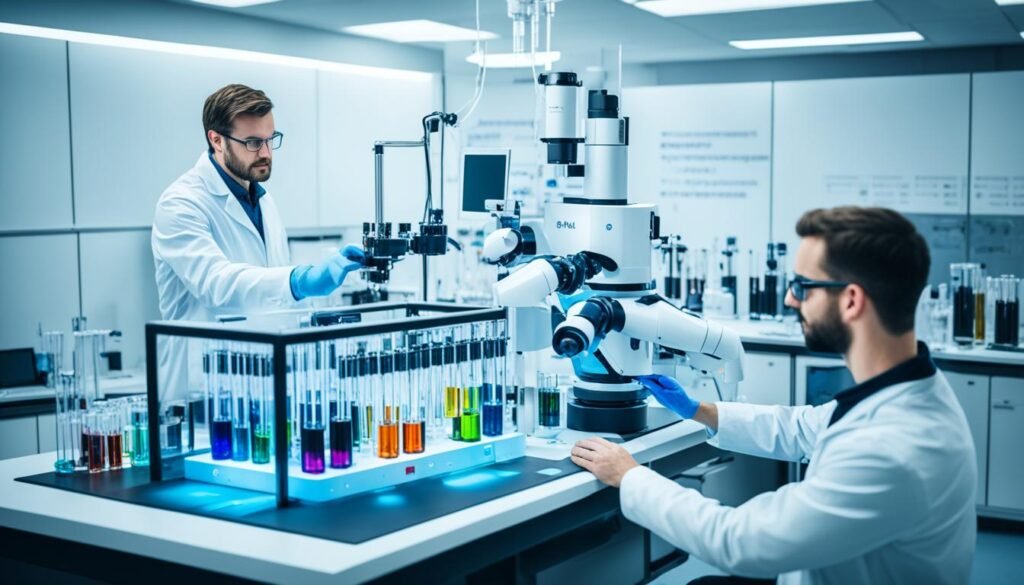
Deep learning algorithms like variational autoencoders and recurrent neural networks have made AI in chemical research even better. These algorithms can create many molecules by learning from big datasets. This helps in designing new molecules and planning their synthesis.
As AI and machine learning in chemistry keep getting better, we’re seeing huge potential in fields like drug development and materials science. The future of chemistry looks bright thanks to these advanced technologies.
can ai solve chemistry problems
Absolutely! AI is a big help in solving many chemistry problems. It can balance chemical equations, predict reaction kinetics, and simulate molecular structures. AI uses advanced algorithms and machine learning to analyze lots of chemistry data. This helps it find patterns and solve complex problems step by step.
The skills of AI in chemistry problem solving are getting better all the time. It makes chemists and researchers work more efficiently. AI is not a full replacement for human knowledge but can help a lot. It lets chemists explore new areas in chemistry.
AI helps with chemistry a lot through computational chemistry. AI simulations and models give insights into molecular structures and reaction mechanisms. This is hard or takes a long time for humans to do. It helps in making new compounds, materials, and drug candidates faster.
- AI tools can balance chemical equations, optimize reaction conditions, and predict outcomes.
- Machine learning can spot patterns in chemical data. This helps AI find promising drug candidates or design new materials.
- Generative AI models like ChatGPT can give step-by-step solutions to complex chemistry problems. They help students and researchers solve problems.
The field of AI chemistry problem solving capabilities is growing fast. We can expect to see more big changes soon. Using AI and chemistry together promises to speed up scientific discoveries, improve industrial processes, and deepen our understanding of chemicals.
“AI is not a replacement for human expertise, but rather a powerful tool that can augment the capabilities of chemists and researchers, helping them tackle challenges more efficiently.” – Dr. Emily Wilkins, Professor of Chemistry
AI-Assisted Drug Discovery and Development
The Impact of AI on Pharmaceutical Research
AI is changing how we find and develop new drugs. It helps researchers quickly spot promising drug candidates and make the process smoother. AI tools look through huge amounts of data to guess how well a drug might work and if it’s safe. They also find new ways to make drugs and the best forms for them.
Using AI in drug discovery and pharmaceutical research cuts down the time and money needed to make new medicines. This means patients get treatments faster. Machine learning and other AI methods are key to this change, bringing new ideas and progress to the industry.
Studies show more people are interested in AI’s role in finding new drugs. Papers in top journals like Drug Discovery Today and Applied Sciences talk about how AI helps predict drug effects, model drug interactions, design new drugs, and forecast drug exposure.
There’s a big increase in AI studies focused on predicting how well drugs work, their safety, and finding treatments for diseases like Alzheimer’s and COVID-19. More pharmaceutical companies are using AI, working with experts to improve their drug search and spark new ideas.
With over 1060 molecules to consider, traditional methods might struggle with the huge data in drug development. But AI can quickly spot important compounds, validate drug targets, and improve drug designs.
AI is set to greatly change the pharmaceutical world. It will help find better drug candidates faster, make the drug development process smoother, and get treatments to patients quicker.
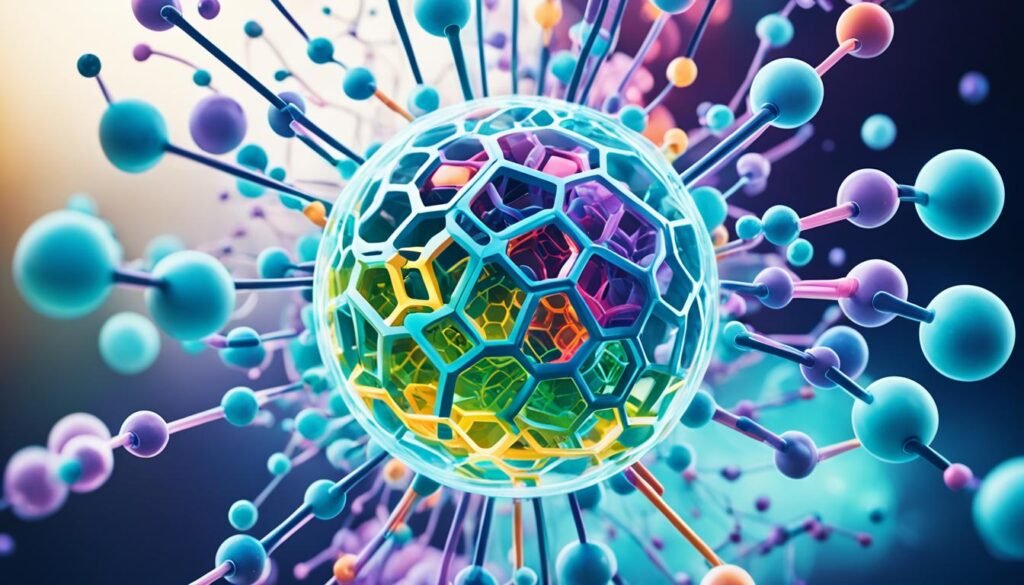
The Future of AI in Chemistry
AI is changing fast, and its future in chemistry is exciting. Researchers are exploring how generative AI can create new molecules and materials. These could change chemistry a lot. Quantum computing and deep learning are also making big strides in chemistry. They let scientists study complex molecules more accurately than before.
AI is now working with other new tech like robotics and the Internet of Things. This mix is making labs more automated. Soon, we’ll see labs that work faster and make decisions based on data. AI is becoming key in chemistry, changing how we do research and find new things.
Emerging Trends and Advancements
- Generative AI models for novel molecule and material design
- Advancements in quantum computing and deep learning for computational chemistry
- Integration of AI with robotics and the Internet of Things for automated chemistry laboratories
- Increased efficiency and cost-effectiveness through data-driven decision-making and high-throughput experimentation
- Accelerated drug discovery and development processes leveraging AI-powered predictive analysis
The future of AI-powered chemistry looks bright. It could lead to new materials and faster drug discovery. AI is set to change chemical research and innovation a lot.
“The integration of AI with other emerging technologies, such as robotics and the Internet of Things, is paving the way for fully automated chemistry laboratories and high-throughput experimentation.”
Limitations and Challenges of AI in Chemistry
AI has shown great skills in solving tough chemistry problems. Yet, there are big hurdles and challenges that need fixing. The success of AI tools depends a lot on the quality and fullness of the data they use. It also depends on the algorithms and computers they run on.
One big issue with AI in chemistry is that we can’t always understand why it gives certain answers. Chemists find it hard to see the logic behind AI’s solutions. This makes it tough to check the results and trust the tech, especially in critical situations where wrong answers could be dangerous.
- The quality and completeness of training data affect how well AI models work in chemistry. Bad or incomplete data can make AI give wrong answers.
- The complexity of chemical systems is hard for AI to handle. It can miss the small details and how chemicals interact with each other.
- The scalability of AI systems is limited. Handling big chemical data and simulations needs a lot of computer power.
To fix these problems, we need to check the results from AI tools carefully. Keeping humans involved in making decisions is key. Research in interpretable machine learning and hybrid AI-human approaches can help bridge the gap between AI’s abilities and what chemists need.
| Limitation | Description | Impact on AI in Chemistry |
|---|---|---|
| Interpretability | It’s hard to understand why AI gives certain answers | This makes it hard to trust and verify AI results in important situations |
| Data Quality | Bad or biased data can lead to wrong predictions | This lowers the accuracy and trust in AI models for chemistry |
| Complexity of Chemical Systems | Chemical processes have many complex interactions AI finds hard to grasp | This limits how well AI can perform in certain chemistry tasks |
| Scalability | Handling big chemical data and simulations needs a lot of computer power | This makes it hard to use AI in places with limited resources or for big chemistry problems |
By working on these issues, the chemistry world can make the most of AI. This will help speed up finding new medicines, improve chemical processes, and design better materials.
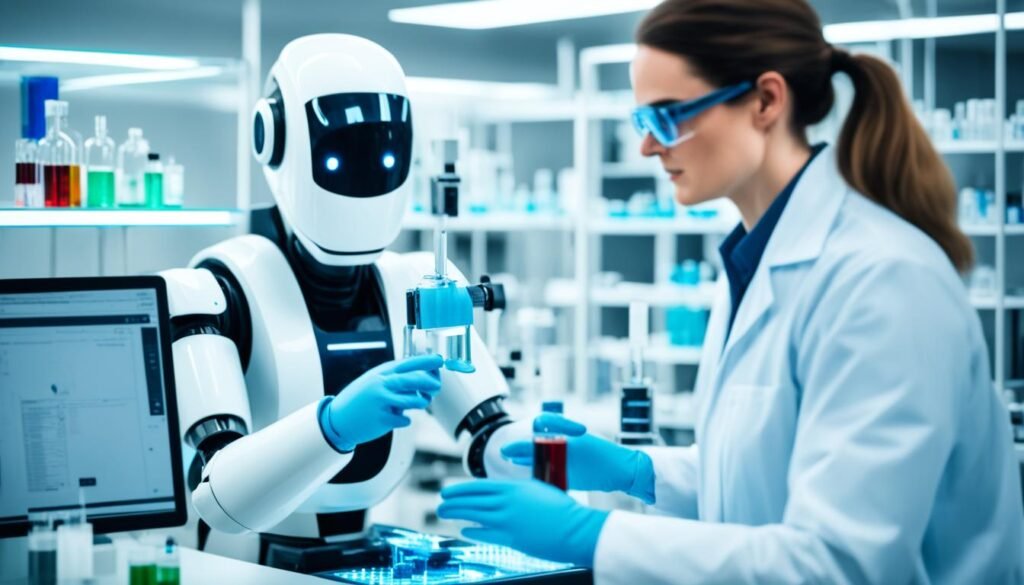
Conclusion
AI has changed the way we tackle scientific challenges in chemistry. It helps solve complex problems and predict chemical properties. AI also speeds up drug discovery and planning for making new compounds.
This technology has made big strides in areas like computational chemistry and predicting chemical reactions. The future looks bright for AI in chemistry. It could make things more efficient, accurate, and innovative.
There are still challenges, like getting more chemical data. But, big tech companies and pharmaceutical firms are investing in AI for chemistry. This suggests a bright future for this partnership. As we see more progress, we can look forward to AI’s impact on science and improving our world.
FAQ
What is an AI chemistry problem solver?
An AI chemistry problem solver is a tool that uses advanced technology to help with chemistry problems. It can predict molecular structures, simulate chemical reactions, and analyze data. It even suggests new ways to make compounds.
How can AI chemistry assistants help students and researchers?
AI chemistry assistants work like personal tutors for students and researchers. They provide step-by-step solutions to problems, explain important concepts, and create practice problems. This helps users understand chemistry better.
Can AI solve complex chemistry equations and formulas?
Yes, AI can handle complex chemistry problems. It breaks down problems, offers detailed solutions, and explains the concepts. This makes complex problems easier to understand.
How is AI transforming molecular modeling and computational chemistry?
AI tools simulate molecule behavior, predict structures, and model reactions accurately and fast. This leads to breakthroughs in drug discovery, materials science, and renewable energy. Researchers can now explore more solutions quickly.
How is AI revolutionizing reaction prediction and synthesis planning?
AI uses machine learning to analyze chemical reactions and predict new synthetic paths. This speeds up drug discovery and the creation of new materials and chemicals.
How does AI help predict chemical properties?
AI and machine learning predict chemical properties like solubility and reactivity by analyzing large datasets. They learn patterns to make accurate predictions about molecules and compounds.
Can AI really solve chemistry problems?
Yes, AI solves many chemistry problems, from balancing equations to simulating molecules. It uses algorithms and machine learning to analyze data, find patterns, and solve complex problems step-by-step.
How is AI transforming drug discovery and development?
AI tools analyze chemical and biological data to predict drug effectiveness and safety. They help find new compounds and the best formulations. This reduces the time and cost of making new medicines.
What is the future of AI in chemistry?
The future of AI in chemistry looks bright. Researchers are using AI to design new molecules and materials. Advances in quantum computing and deep learning are opening new areas in computational chemistry.
What are the limitations and challenges of using AI in chemistry?
AI’s accuracy depends on the data quality and algorithms used. Chemists may find it hard to understand AI’s reasoning. It’s important to check AI’s results and keep human expertise involved.
